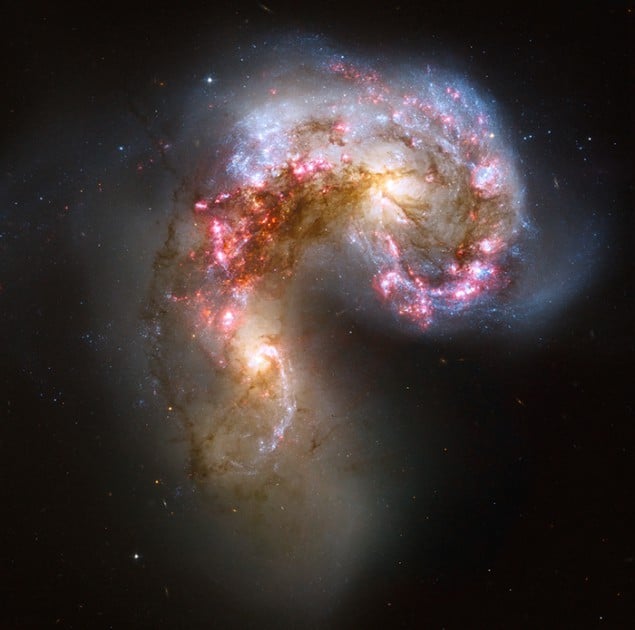
Most of the stars in the universe were born within spiral galaxies like the Milky Way but now find themselves inside “dead” elliptical galaxies, according to new analysis of data from the Hubble and Herschel space telescopes. Astronomers led by Steve Eales of Cardiff University, UK, have shown that 83% of stars in the universe were born in spiral galaxies, but today only about 49% of stars exist in spirals. According to the team, this means that many spiral galaxies have somehow transformed themselves into elliptical ones.
When two spiral galaxies collide, astronomers believe that they will merge into a single elliptical galaxy, which is a giant, amorphous spheroid of stars. The merger process uses up all of the spare star-forming gas in the colliding galaxies, and this means that elliptical galaxies have no gas left with which to form new stars. However, there was no quantifiable evidence that there has been a widespread transformation of spirals into ellipticals, until now.
Galactic energy
The latest research is based on a survey of 10,000 galaxies in the nearby universe selected from the Herschel Astrophysical Terahertz Large Area Survey and the Galaxy and Mass Assembly Survey. It also includes galaxies in the early universe, as seen in Hubble’s Cosmic Assembly Near-infrared Deep Extragalactic Legacy Survey project. These data allowed Eales’s team to measure how much energy is coming from stars in disc galaxies and elliptical galaxies, respectively, at different times in the history of the universe.
“By measuring the total amount of energy from a particular patch of sky, we could work out how many stars have formed to generate that energy,” Eales told physicsworld.com. “Then we looked at the fraction of the energy associated with disc galaxies and the fraction associated with elliptical galaxies.”
The further afield one looks, the smaller and more indistinct galaxies become, until it becomes difficult to determine what type of galaxy they are. To address this, Eales’s team applied the Sérsic profile, which measures brightness across a galaxy. Spiral galaxies are distinguished by having different brightness profiles to ellipticals.
Stellar milestone
If Eales’s team is correct, then the universe has now reached a milestone, with more than half of its stars existing in elliptical galaxies and star formation continuing to dwindle across the universe. Indeed, ellipticals comprise cooler, redder, longer-lived stars with little star formation and are often described as being “red and dead”.
Team-member Dave Clements at Imperial College, London, adds: “The star-formation rate is certainly dropping, which means that the amount of energy being produced by stars is also declining.”
However, not everyone agrees with the team’s conclusions. Richard Bower, an astrophysicist at Durham University, UK, is concerned that our understanding of the total energy output of star-forming galaxies in the very distant universe is too uncertain to be able to come up with a firm figure of 83% without numerous assumptions being made.
“I’m not convinced that you can determine those things as accurately as you would need to in order to come to a strong conclusion,” he says.
Not dead yet
Furthermore, Bower’s own work with Durham’s Evolution and Assembly of Galaxies and their Environments project, which models the formation of galaxies across large volumes of the universe, suggests that galaxy evolution need not stop at “red and dead”.
“We see galaxies forming stars, stopping, turning red, but then something will happen to rejuvenate them and they’ll go back to forming stars, possibly at a lower rate,” says Bower. Indeed, in 2012 astronomers used Hubble to identify clouds of cool and potentially star-forming gas around 16 “dead” elliptical galaxies.
Eales agrees that sometimes galaxy evolution can run backwards. “There are a lot of processes that could cause galaxies to move in the opposite direction, but the dominant process still seems to be this disc-to-elliptical transformation,” he says.
The research is described in Monthly Notices of the Royal Astronomical Society.



